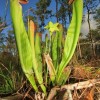 Pitcherplants are perennial plants with groups of leaves modified into traps or pitchers. They have tubular leaves with lids or hoods at the top that secrete nectar to attract prey. Once insects are on the lip of the pitcher, they can slip on the waxy opening and fall into the plant. This 5-page fact sheet provides descriptions of the ranges, appearance, and flowering of the six pitcherplant species native to Florida. Written by Megan E. Brown and Debbie L. Miller, and published by the UF Department of Wildlife Ecology and Conservation, January 2013.
Pitcherplants are perennial plants with groups of leaves modified into traps or pitchers. They have tubular leaves with lids or hoods at the top that secrete nectar to attract prey. Once insects are on the lip of the pitcher, they can slip on the waxy opening and fall into the plant. This 5-page fact sheet provides descriptions of the ranges, appearance, and flowering of the six pitcherplant species native to Florida. Written by Megan E. Brown and Debbie L. Miller, and published by the UF Department of Wildlife Ecology and Conservation, January 2013.
http://edis.ifas.ufl.edu/uw378
Tag: Wetlands
Florida’s Seepage Slope Wetlands (WEC322/UW367)
 Florida is home to one of North America’s most unique and diverse ecosystems, the seepage slope. Unusual hydrology and frequent fires combine to create an environment that supports a variety of carnivorous and other sun-loving herbaceous plants. This 5-page fact sheet discusses the natural history and conservation concerns associated with seepage slope wetlands. Written by Megan E. Brown and Debbie L. Miller, and published by the UF Department of Wildlife Ecology and Conservation, June 2012.
Florida is home to one of North America’s most unique and diverse ecosystems, the seepage slope. Unusual hydrology and frequent fires combine to create an environment that supports a variety of carnivorous and other sun-loving herbaceous plants. This 5-page fact sheet discusses the natural history and conservation concerns associated with seepage slope wetlands. Written by Megan E. Brown and Debbie L. Miller, and published by the UF Department of Wildlife Ecology and Conservation, June 2012.
http://edis.ifas.ufl.edu/uw367
WEC281/UW326 Conservation Subdivision: Design Phase: Wetland Considerations
WEC281, a 4-page illustrated fact sheet by Mark Hostetler, discusses issues surrounding on-site protection of wetlands and strategies to create wetlands that conserve biodiversity when land is subdivided. Includes references. Published by the UF Department of Wildlife Ecology and Conservation, March 2010.
http://edis.ifas.ufl.edu/uw326
WEC268/UW313 Isolated Wetlands and Breeding Amphibians
WEC268, a 4-page illustrated fact sheet by Taryn A. Sudol, Emma V. Willcox, and William Giuliano, explains what isolated wetlands are, why they are important, and how they can be managed for amphibians. Published by UF Department of Wildlife Ecology and Conservation, September 2009.
http://edis.ifas.ufl.edu/UW313
SL294/SS507 Dissolved Organic Matter in Wetlands
SL-294, a 3-page illustrated fact sheet by Alan L. Wright and K. R. Reddy, describes the importance of dissolved organic matter and its role in regulating nutrients in terrestrial and aquatic ecosystems. Published by the UF Department of Soil and Water Science, June 2009.
http://edis.ifas.ufl.edu/SS507
SL297/SS510 Reactivity and Mobility of Metals in Wetlands
SL-297, a 3-page fact sheet by Alan L. Wright and K.R. Reddy, discusses the role of metals in wetlands, their function, changes they undergo, and the potential hazards associated with their presence and accumulation in wetlands. Includes references. Published by the UF Department of Soil and Water Science, June 2009.
http://edis.ifas.ufl.edu/SS510
SL302/SS515 Environmental Consequences of Water Withdrawals and Drainage of Wetlands
SL-302, a 3-page fact sheet by Alan L. Wright, educates the general public about how hydrologic conditions, such as drought and water withdrawal, influence the functioning and benefits of wetland ecosystems. Includes references. Published by the UF Department of Soil and Water Science, July 2009.
http://edis.ifas.ufl.edu/SS515
SL289/SS502 Wetland Delineation: An Overview of Regulations and Methods
SL289, a 4-page illustrated fact sheet by Daniel L. Irick, Yuncong Li, and Alan L. Wright, describe the regulatory nature of wetland delineation and classification for landowners, wetland and soil scientists, and the
general public. Includes references. Published by the UF Department of Soil and Water Science, May 2009.
http://edis.ifas.ufl.edu/SS502
SL304/SS517 Wetland Eutrophication: Early Warning Biogeochemical Indicators
SL-304, a 3-page illustrated fact sheet by Alan L. Wright, describes the effects of nutrients in the Everglades and identifies sensitive early-warning indicators of ecological changes. Includes references. Published by the UF Department of Soil and Water Science, July 2009.
http://edis.ifas.ufl.edu/SS517
ENH1090/EP354 Methodology for Wetland Seedbank Assays
ENH-1090, a 6-page illustrated fact sheet by Carrie Reinhardt Adams and Nancy M. Steigerwalt, summarizes standard techniques for wetland seed bank assays, including greenhouse set-up, sample collection and sample processing. Includes references. Published by the UF Department of Environmental Horticulture, February 2008.
http://edis.ifas.ufl.edu/EP354
SL257/SS481 Wetland Ecological Models
SL-257, a 6-page illustrated fact sheet by H.C. Fitz and N. Hughes, summarizes the types of ecological models that are used to better understand “natural” wetland ecology. Includes references. Published by the UF Department of Soil and Water Sciences, February 2008.
http://edis.ifas.ufl.edu/SS481